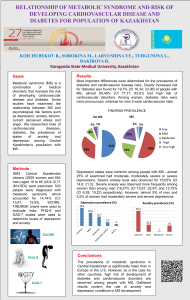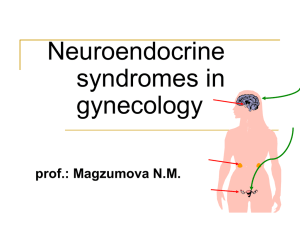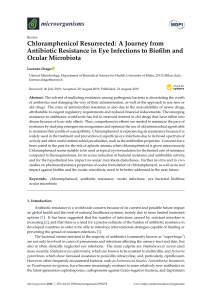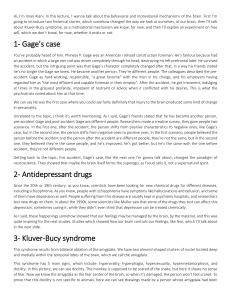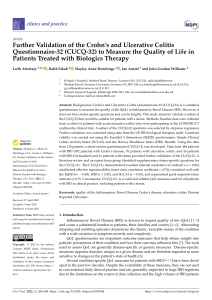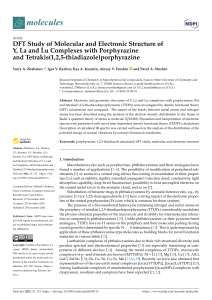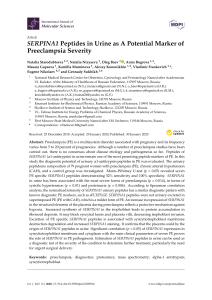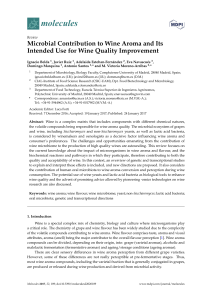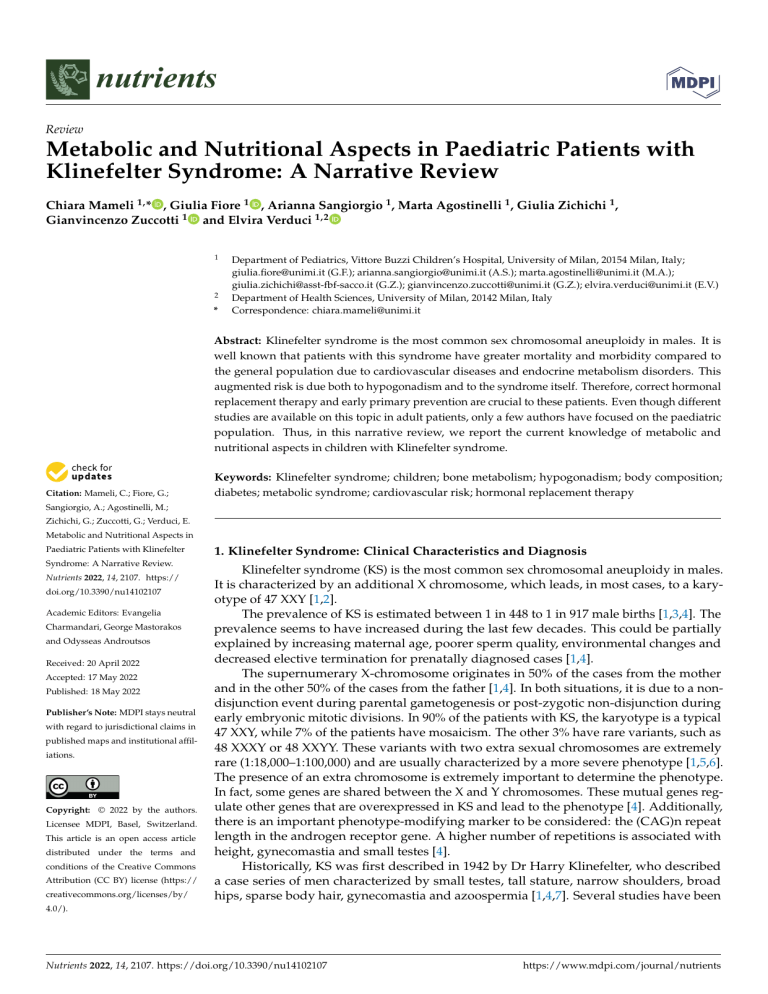
nutrients Review Metabolic and Nutritional Aspects in Paediatric Patients with Klinefelter Syndrome: A Narrative Review Chiara Mameli 1, * , Giulia Fiore 1 , Arianna Sangiorgio 1 , Marta Agostinelli 1 , Giulia Zichichi 1 , Gianvincenzo Zuccotti 1 and Elvira Verduci 1,2 1 2 * Department of Pediatrics, Vittore Buzzi Children’s Hospital, University of Milan, 20154 Milan, Italy; [email protected] (G.F.); [email protected] (A.S.); [email protected] (M.A.); [email protected] (G.Z.); [email protected] (G.Z.); [email protected] (E.V.) Department of Health Sciences, University of Milan, 20142 Milan, Italy Correspondence: [email protected] Abstract: Klinefelter syndrome is the most common sex chromosomal aneuploidy in males. It is well known that patients with this syndrome have greater mortality and morbidity compared to the general population due to cardiovascular diseases and endocrine metabolism disorders. This augmented risk is due both to hypogonadism and to the syndrome itself. Therefore, correct hormonal replacement therapy and early primary prevention are crucial to these patients. Even though different studies are available on this topic in adult patients, only a few authors have focused on the paediatric population. Thus, in this narrative review, we report the current knowledge of metabolic and nutritional aspects in children with Klinefelter syndrome. Citation: Mameli, C.; Fiore, G.; Keywords: Klinefelter syndrome; children; bone metabolism; hypogonadism; body composition; diabetes; metabolic syndrome; cardiovascular risk; hormonal replacement therapy Sangiorgio, A.; Agostinelli, M.; Zichichi, G.; Zuccotti, G.; Verduci, E. Metabolic and Nutritional Aspects in Paediatric Patients with Klinefelter Syndrome: A Narrative Review. Nutrients 2022, 14, 2107. https:// doi.org/10.3390/nu14102107 Academic Editors: Evangelia Charmandari, George Mastorakos and Odysseas Androutsos Received: 20 April 2022 Accepted: 17 May 2022 Published: 18 May 2022 Publisher’s Note: MDPI stays neutral with regard to jurisdictional claims in published maps and institutional affiliations. Copyright: © 2022 by the authors. Licensee MDPI, Basel, Switzerland. This article is an open access article distributed under the terms and conditions of the Creative Commons Attribution (CC BY) license (https:// creativecommons.org/licenses/by/ 1. Klinefelter Syndrome: Clinical Characteristics and Diagnosis Klinefelter syndrome (KS) is the most common sex chromosomal aneuploidy in males. It is characterized by an additional X chromosome, which leads, in most cases, to a karyotype of 47 XXY [1,2]. The prevalence of KS is estimated between 1 in 448 to 1 in 917 male births [1,3,4]. The prevalence seems to have increased during the last few decades. This could be partially explained by increasing maternal age, poorer sperm quality, environmental changes and decreased elective termination for prenatally diagnosed cases [1,4]. The supernumerary X-chromosome originates in 50% of the cases from the mother and in the other 50% of the cases from the father [1,4]. In both situations, it is due to a nondisjunction event during parental gametogenesis or post-zygotic non-disjunction during early embryonic mitotic divisions. In 90% of the patients with KS, the karyotype is a typical 47 XXY, while 7% of the patients have mosaicism. The other 3% have rare variants, such as 48 XXXY or 48 XXYY. These variants with two extra sexual chromosomes are extremely rare (1:18,000–1:100,000) and are usually characterized by a more severe phenotype [1,5,6]. The presence of an extra chromosome is extremely important to determine the phenotype. In fact, some genes are shared between the X and Y chromosomes. These mutual genes regulate other genes that are overexpressed in KS and lead to the phenotype [4]. Additionally, there is an important phenotype-modifying marker to be considered: the (CAG)n repeat length in the androgen receptor gene. A higher number of repetitions is associated with height, gynecomastia and small testes [4]. Historically, KS was first described in 1942 by Dr Harry Klinefelter, who described a case series of men characterized by small testes, tall stature, narrow shoulders, broad hips, sparse body hair, gynecomastia and azoospermia [1,4,7]. Several studies have been 4.0/). Nutrients 2022, 14, 2107. https://doi.org/10.3390/nu14102107 https://www.mdpi.com/journal/nutrients Nutrients 2022, 14, 2107 2 of 16 performed since the 1940s and the knowledge regarding KS has largely increased. Mild-tomoderate cognitive deficits have been added as symptoms of KS [8]. Moreover, we currently know that an alternative phenotype with fewer clinical features is widely represented [7]. Hypogonadism is a central element of KS. The testicular underdevelopment and dysfunction could be as early as infancy [2]. Already during mini-puberty in some patients, there is a blunted testosterone surge compared to their peers [4]. Germ cells are fewer than normal and their deficit worsens while the patient grows until in adulthood, when spermatogenesis is almost suppressed [7]. The hypothalamic–pituitary–gonadal axis (HPG axis) has normal activity; therefore, it is quiescent during childhood and is activated at the beginning of puberty. In many cases, the pubertal onset is normal [4,7]. Nevertheless, the testes usually reach a maximal volume of 10 mL and then decrease to 4 mL [7]. The signs and symptoms of KS vary depending on age. In a few cases, newborns can show signs of hypogonadism, such as a micropenis, cryptorchidism and hypospadias [9]. In the case of a micropenis, treatment with testosterone should be suggested [7]. Symptoms that lead to a diagnosis during childhood are usually underdevelopment of genitalia, hypotonia, developmental delays and learning and behaviour problems. In particular, 75% of children with KS present speech–language delay, 50% have motor-skills delays and between 36 and 63% are diagnosed with Attention Deficit Hyperactivity Disorder (ADHD) [1]. Too often, when the presenting symptoms are neurological disabilities, there is a delay in the diagnosis of KS. Patients with KS are diagnosed during adolescence due to small testicles, gynecomastia or delayed puberty. However, often, the diagnosis is made during adulthood during investigations for infertility or in patients who present signs and symptoms of hypogonadism [1]. To date, we know there is an important discrepancy between the known prevalence of KS and the rate of clinical diagnosis [4]. In fact, only 25–35% of the patients with KS are diagnosed during their life, while most of the patients are left without a diagnosis [1,7]. Considering the males who received a diagnosis, approximately 10% of the cases are diagnosed during prenatal screening, 6% in childhood or adolescence and 19% in adulthood [1]. During adolescence, hormonal exams could be useful for diagnosis. In fact, testosterone may rise normally at the beginning of puberty; however, it usually decreases to lower-normal or subnormal levels. In response to this phenomenon, luteinizing hormone (LH) and follicle-stimulating hormone (FSH) rise 1–2 years after the beginning of puberty. Moreover, inhibin B (INHB) and anti-Mullerian hormone (AMH) are low or undetectable [1]. Once KS is suspected based on clinical and hormonal data, a genetic test is mandatory in order to make a diagnosis [1]. If KS is found early in infancy or even at the prenatal tests, the patient should undergo an adequate follow-up [4]. In particular, it is extremely important that children with KS are tested with periodical neuropsychological evaluations. Moreover, periodical endocrinological visits with pubertal examinations and hormonal dosages are suggested, starting from 10 years old or at the first sign of puberty, depending on which comes first. Currently, there are no universal guidelines that indicate when androgen replacement should be begun. Some authors suggest waiting until signs or symptoms of hypogonadism appear. Others prefer to start low testosterone doses at the first abnormal rise of LH. Testosterone is administered with depot injection or topical gel. In order to preserve the possibility of paternity, it is crucial to refer the patient to a centre specialized in advanced reproductive technology, in particular in testicular sperm extraction [1]. It is extremely important to remind that KS is not only about hypogonadism and neurodevelopment. Different studies have focused on the long-term consequences of KS, showing that Klinefelter patients have greater morbidity and mortality [10,11]. The median survival rate is 2 to 5 years lower compared to peers. The augmented mortality rate is connected especially to cardiovascular diseases and endocrine metabolism disorders [3,12]. In fact, KS could have effects on body composition, insulin sensitivity, bone metabolism and cardio- Nutrients 2022, 14, 2107 3 of 16 vascular morbidity, with an increased risk of diabetes, metabolic syndrome, osteoporosis and cardiac disease [7,13]. For these reasons, in this narrative review, we focus on the metabolic and nutritional aspects of KS, particularly in the paediatric population. These aspects are extremely important considering that early diagnosis will be more frequent due to prenatal tests. Therefore, a correct approach to nutrition and hormonal therapy in children and adolescents with KS will be necessary in order to reduce the cardiometabolic risk and, consequently, morbidity and mortality. 2. Methods A narrative review was performed starting on 29 January 2022 [14]. The most relevant original scientific papers, clinical trials, meta-analyses and reviews published in the English language, on a specific topic, were reviewed. The following keywords (alone or in combination) were considered: “Klinefelter syndrome”, “children”, “bone metabolism”, “hypogonadism”, “body composition”, “diabetes”, “metabolic syndrome”, “cardiovascular risk”, “hormonal replacement therapy”. Approximately 87 papers were considered. The electronic databases PubMed, Scopus, EMBASE and Web of Science were used for this research. The resulting draft was discussed with all co-authors. The final version was then recirculated and approved by all. 3. Metabolic Aspects It is well known that adult patients with hypogonadism present several metabolic alterations independently from KS. In fact, in the general adult male population, hypogonadism is associated with abnormal body composition, metabolic syndrome, insulin resistance, diabetes, elevated cardiovascular risk and osteoporosis [7]. Moreover, there is a vicious circle between abdominal adiposity and insulin resistance, with abdominal adiposity causing insulin impairment [7,15]. In addition, insulin resistance usually worsens hypogonadism by lowering hypothalamic activity and impairing Leydig cell function [12]. Despite the clear connection between hypogonadism and metabolic alterations, in patients affected by KS, this interaction is extremely complex because hypogonadism is not the only factor that should be considered [4]. In fact, metabolic abnormalities partially subsist due to the genetic disease itself [12]. Few studies have evaluated the metabolic aspects in paediatric patients affected by Klinefelter syndrome so far. Table 1 summarizes the state of the art in the paediatric population to date. Table 1. Summary of studies evaluating metabolic aspects in paediatric patients affected by Klinefelter syndrome. Authors Type of Study Population Intervention or Objective Results Diabetes Davis et al. 2020 [16] Bardsley et al. 2011 [17] Cross-sectional study Observational prospective study 50 KS adolescents age 10–18 years evaluate cardio-metabolic risk in KS adolescents compared to 50 age- and BMI-matched healthy controls. Subgroup analysis performed in regard of TRT therapy 89 prepubertal KS boys age 4–12 years compare auxologic measures and truncal obesity in prepubertal boys with KS versus age-matched controls (n = 34) • HbA1c was significantly higher in KS patients, indicative of chronically higher blood glucose • Truncal obesity, insulin resistance and metabolic syndrome were present in KS boys as young as 4–12 years, and these occurred in association with reduced running-type activity 24% of the boys with KS had had IR • Nutrients 2022, 14, 2107 4 of 16 Table 1. Cont. Authors Type of Study Population Intervention or Objective Results Metabolic syndrome • Bardsley et al. 2011 [17] Observational prospective study 89 prepubertal KS boys age 4–12 years compare auxologic measures and truncal obesity in prepubertal boys with KS versus age-matched controls (n = 34) • • • • Davis et al. 2016 [18] Observational study 93 pre-pubertal boys with KS age 4–12 years assess the relationship of gonadal and cardiometabolic function in children with KS • • • Davis et al. 2017 [19] Double-blind RCT 79 pre-pubertal boys with KS age 4–12 years children were randomized to receive oral oxandrolone (Ox) 0.06 mg/kg/d (n = 38) or placebo (n = 41) for 2 years. • • BMI measurements were similar, but waist circumference was >90 percentile in 30% of boys with KS versus 21% of controls. 8% of children met the three criteria required for MetS diagnosis 36% met two features of MetS 37% of the boys with KS had elevated LDL cholesterol 80% of children had ≥1 feature of metabolic syndrome * (MetS) and 11% had ≥3 features of MetS * risk of MetS was independent of age and BMI. 18% had an INHB below the normal range, and a low INHB was associated with higher FBG, triglycerides, LDL and lower HDL (p < 0.05). INHB <50 ng/dL yielded a sensitivity of 83.3% and a specificity of 79.2% for having ≥3 features of MetS in boys <9.5 years of age Ox resulted in lower TG (p = 0.043) but also HDL cholesterol (p = 0.001) The number of children who met criteria for MetS * did not differ between groups at 2 years Cardiovascular risk • • Davis et al. 2020 [16] Cross-sectional study 50 KS adolescents age 10–18 years evaluate cardio-metabolic risk in KS adolescents compared to ageand BMI-matched healthy controls. Subgroup analysis performed in regard of TRT therapy • • • KS group showed a 96% prevalence of at least one cardio-metabolic (CM) risk feature KS adolescents showed 2.5 times greater risk of having “three or more CM risk features” compared to their peers with similar BMI. KS adolescents with normal range BMI z score (controls 0.36 ± 1.2 vs. KS 0.31 ± 1.3) might already have an increased CM risk compared to controls In KS group, BMI z score positively correlated with systolic BP percentile (r = 0.50; p < 0.001) and triglycerides (r = 0.32, p = 0.03). TRT subgroup showed lower systolic BP percentile (p = 0.033) and approximately half of the prevalence in “three or more CM risk features” vs. not treated with TRT (18% vs. 38%), although with no significance (p = 0.13). Bone metabolism • Aksglaede et al. 2007 [20] Retrospective cross-sectional study 24 children with a median age of 11.0 years (range 4.3–18.6) 18 untreated; 6 received oral testosterone undecanoate (40 mg twice daily increasing to 80 mg twice daily) for a median period of 1.3 years • • Weight, BMI and LBM did not differ from age-matched controls, whereas height, BFM were significantly increased. No difference between treated and untreated patients with KS. Lumbar BMD and whole-body BMC were normal, indicating normal bone mineralization in both treated and untreated boys and adolescents. Nutrients 2022, 14, 2107 5 of 16 Table 1. Cont. Authors Type of Study Population Intervention or Objective Results Testosterone replacement therapy and adiposity • Davis et al. 2017 [19] Double-blind, placebocontrolled RCT 93 boys age 4–12 years Administration of oral oxandrolone (0.06 mg/kg/day) or placebo for 2 years Davis et al. 2019 [21] Prospective randomized trial 20 infants, 6–15 weeks of age Administration of 25 mg testosterone cypionate intramuscular monthly for three doses vs. no treatment • • %BF SDS at 2 years was significantly lower in the treatment (0.29 ± 0.76 SDS) compared with placebo group (0.81 ± 0.72 SDS) after adjusting for age and baseline %BF SDS. TRT improved cardiometabolic markers; in fact, %BF at 2 years was significantly lower in treatment group; however, it caused lower HDL cholesterol and advanced bone age Testosterone treatment resulted in positive changes in body composition Testosterone replacement therapy and cognitive function SamangoSprouse et al. 2013 [22] Placebocontrolled RCT 101 children 36–72 months of age Administration of injections (25 mg each) of testosterone enanthate, or placebo. 1 injection/month for 3 months 34 treated, 67 untreated Ross et al. 2017 [23] Placebocontrolled RCT 84 children age 4–12 years Administration of oxandrolone (0.06 mg/kg daily) or placebo for 24 months 43 treated, 41 untreated • There were significant differences in multiple cognitive domains in the group that received androgen treatment, including multiple measures of language, intellectual and neuromotor skills. • Benefited visual–motor function and positive effects on anxiety, depression, social problems • In XXY infants, FSH, LH, INHB and AMH did not differ from controls Testosterone levels during the first trimester exhibited a physiological increase but were lower than in controls (p < 0.0001). Significant correlations were found between testosterone and LH (p < 0.001), between INHB and FSH (p = 0.0011) and between AMH and INHB (p = 0.025). In XXY adolescents, AMH and INHB were undetectable. Testosterone secretion is impaired in infants with Klinefelter syndrome. By contrast, INHB and AMH secretions were not altered Hypogonadism and hormonal aspects • Lahalou et al. 2004 [24] Observative prospective study 18 KS infants from birth to 3 years Blood samples were collected from birth to 3 years of age and compared with those in 6 adolescents (14–18 years) with XXY karyotype and reference values established in 215 control infants • • • • Ross et al. 2005 [25] Observative prospective study 22 infants and young boys with KS, age 1–23 months Auxologic measurements, biologic indices of testicular function by blood samples and clinical assessment of muscle tone in KS infants were measured. • • • Mean length, weight and head circumference in SDS were generally within the normal range at –0.3 ± 1.0, −0.1 ± 1,4 and 0.0 ± 1.5, respectively. Mean penile length and testicular volume SDS were –0.9 ± 0.8 and –1.1 ± 0.8, indicating significantly reduced penile and testicular size. Mean testosterone levels for the boys < 6 and > 6–23 months were 128 ± 131 (4.4 + 4.5 nmol/L) and 9.5 ± 7.2 ng/dL (0.3 ± 0.2 nmol/L), respectively. Hypotonia was present in 12/17 boys Klinefelter syndrome (KS); randomized controlled trial (RCT); body mass index (BMI); body fat percentage (%BF); standard deviation score (SDS); lean body mass (LBM); body fat mass (BFM); testosterone replacement therapy (TRT); insulin resistance (IR); metabolic syndrome (MetS); inhibin B (INHB); waist circumference (WC); triglycerides (TG); glycated haemoglobin (HbA1c); low density lipoprotein (LDL); high density lipoprotein (HDL); fasting blood glucose (FBG); blood pressure (BP); oral oxandrolone (Ox), bone mineral content (BMC); bone mineral density (BMD); follicle-stimulating hormone (FSH); luteinizing hormone (LH); anti-Mullerian hormone (AMH); inhibin B (INHB). * MetS defined as ≥ 3 of the following: WC > 75% for age, fasting FG > 100 mg/dL, HDL < 50 mg/dL, FBG > 110 mg/dL and systolic or diastolic BP > 90% for age and height. Nutrients 2022, 14, 2107 6 of 16 3.1. Adiposity There is a growing clinical and scientific interest in the metabolic alterations and the unfavourable changes in body composition present in KS patients since childhood. They typically have a tall stature, perhaps caused by SHOX duplication, and specific anthropometric findings, such as increased length, width and hip circumference [26]. As mentioned beforehand, androgens play an important role in regulating adipogenesis and body fat distribution. Hypogonadism, common in adults with KS, has been found to be an independent risk factor for increasing truncal adiposity and diabetes in men with normal karyotypes [27–29]. Nevertheless, some authors reported an increased deposit of body fat, by the age of ten years in patients with KS, measuring subscapular and triceps skinfolds [30]. In prepubertal boys with KS, age 4 to 12 years, an increase in waist circumference and an increased risk of metabolic syndrome have been demonstrated [15,17]. Furthermore, in a recent cross-sectional study, Aksglaede et al. showed that an unbalanced body composition among KS adults may already be present before puberty. In prepubertal subjects, with a median age of 11 years old, an increasing body fat mass (BFM), height and BF% were found upon a DEXA scan despite age-normal BMI, lean body mass (LBM) and weight for age, compared with normal boys, probably due to an unfavourable muscle-to-fat ratio. Moreover, increased BFM was demonstrated in both testosterone-treated and untreated KS children [20]. However, Davis et al. demonstrated, in randomized controlled trials, that testosterone replacement therapy (TRT) could reduce BF % in both infancy and childhood [19,21]. Data on this topic are not unequivocal and, therefore, more studies are needed [19,21]. The findings of increased amounts of body fat in prepubertal boys suggest the weakness of the hypothesis that hypogonadism and low testosterone precede obesity. The multivariate analysis highlighted that abdominal obesity is primarily responsible for the decrease in insulin sensitivity, even when serum testosterone levels are in the normal range [31]. In fact, leptin, a biomarker of the total body fat amount, is greatly elevated [29]. The temporal occurrence of events is unknown, so it is not possible to assess whether hypogonadism is responsible for the increase in abdominal adiposity or whether increased truncal fat leads to reduced testosterone production. Perhaps there is a self-perpetuating vicious circle between obesity and hypogonadism, in which increased abdominal fat reduces the insulin sensitivity of cells, in particular Leydig cells, thus causing a progressive decrease in testosterone production [29]. Moreover, there is a possible genetic influence of body fat in KS in early childhood due to the overexpression of X-linked genes, skewed X-chromosome inactivation or CAG-repeat polymorphism in the androgen receptor as well as the influence of hypogonadism after puberty [32]. Furthermore, in a mouse model of KS, it was evidenced that only the owned number of X-chromosomes and not the differential levels of gonadal hormone influence fat storage and food intake, leading to obesity [33]. In conclusion, even though not all of the KS population develops obesity, unfavourable body composition is common and represents a key risk factor for morbidity [19,21]. 3.2. Diabetes Many studies have demonstrated an association between KS and diabetes, in both adulthood and childhood, although the risk factors have not been fully elucidated [13,17]. This theory is supported in part by epidemiologic data on mortality and hospitalizations in patients with KS, where the mortality rate from diabetes is significantly increased [31]. Interestingly, type 2 diabetes (T2D) has some specific features in these patients. Diabetes seems to occur earlier in life compared to the healthy population, around the age of 30 years; it shows lower insulin sensitivity and higher insulin secretion [34]; blood glucose may not be well controlled despite insulin administration; it affects patients with a low BMI or within the normal range at the diagnosis, unlike the typical non-KS-subject with T2D [35]. In adult patients affected by KS, the fasting serum insulin and fasting plasma Nutrients 2022, 14, 2107 7 of 16 glucose were higher, whereas insulin sensitivity was significantly reduced [31]. Moreover, the increased islet β-cell secretion function was statistically significant compared with those patients with hyperglycaemia but without KS [31]. Using the hyperinsulinemic euglycemic clamp test, Lee et al. reported that impaired peripheral insulin resistance was the underlying mechanism of impaired glucose tolerance in adult Korean patients with KS [34]. Accordingly, Yesilova et al. reported that one third of the adult KS patients have an increased incidence of insulin resistance (IR) and hyperinsulinemia [36]. We do not know when the glucose metabolism impairment exactly starts; however, it seems reasonable to suppose that early adolescence is the most critical period. Davis et al. studied a group of adolescents with KS without a diagnosis of T2D and healthy controls between 10 and 17 years. They reported a higher HbA1c in KS patients than in healthy adolescents, which is indicative of chronically higher blood glucose [16]. More studies are needed in this field to support this hypothesis. As previously reported, hypogonadism is an independent risk factor for the development of diabetes in men with normal chromosomes [37–39]; however, the prevalence of T2D is higher in Klinefelter patients than in idiopathic hypogonadotropic hypogonadism, even though both are androgen deficient and receive testosterone replacement therapy, thus suggesting that this relationship is independent of serum testosterone level [13], and this could be an association rather than the cause. However, the chromosomal abnormality could act through other mechanisms in triggering IR, and these could be studied in KS boys at a prepubertal age. Indeed, they have similar circulating plasma levels of testosterone and gonadotropin at a prepubertal age to healthy age-matched controls of the same age despite presenting the genetic alteration typical of this disease since birth [20]. Accordingly, Bardsley et al. reported that, among 89 boys younger than 12 years old, 24% of them were insulin-resistant (according to HOMA-I) [17]. Furthermore, autoimmunity is also frequent in KS. In support of this speculative hypothesis, a recent study showed that immunoreactivity directed against diabetes-specific autoantigens of type 1 diabetes was significantly higher in KS (8.2%) than in paired controls. However, the endocrine autoantibody profile of testosterone-treated and untreated KS patients was not different [40]. Moreover, the worse the karyotype, the higher the prevalence of diabetes, probably because of the presence of an extra-X-chromosome [13]. Other mechanisms, such as changes in body composition, inflammation status, high triglyceride levels, fatty liver and acute pancreatitis, might also play an important role in the development of diabetes mellitus in KS patients [13]. However, the specific pathogenesis has yet to be elucidated, and further research is needed to clarify the complex interaction between genotype and metabolic phenotype in KS patients [41]. 3.3. Metabolic Syndrome Recent studies have evaluated MetS’ prevalence and occurrence since paediatric age in KS children. Bardsley et al. investigated the risk factors for MetS in 89 prepubertal KS boys age 4–12 years [17]. Since different definitions of metabolic syndrome in childhood subsist, the authors applied the metabolic syndrome criteria set by the Third National Health and Nutrition Examination Survey [42]. In particular, MetS was defined as ≥3 of the following: fasting TG ≥ 100 mg/dL; HDL < 50 mg/dL; WC > 75◦ percentile for age; systolic/diastolic BP > 90◦ percentile and FBG ≥ 100 mg/dL. Overall, 8% of the children met the three criteria required for diagnosis, while 36% met two features of MetS. Thus, it appears that, in this prepubertal cohort of boys with KS, the risk for metabolic syndrome is already increased [17]. Similarly, Davis et al. studied the relationship between gonadal and metabolic functions in a cohort of 93 prepubertal children (4–12 years) [18]. Despite a normal BMI Nutrients 2022, 14, 2107 8 of 16 percentile in 95% of the subjects, at least one feature of MetS was present in 79%, while full MetS criteria were met in 11% according to previous criteria [42]. The risk of MetS was independent of age and body mass index. Moreover, the authors evaluated gonadal function via INHB, a biomarker of Sertoli cells dysfunction. They found that an INHB cut-off of ≤50 ng/dL yields a sensitivity of 83.3% and specificity of 79.2% for meeting the full criteria for MetS in boys <9.5 years of age. Thus, pre-pubertal children with the highest risk of meeting MetS criteria were those with lower values of INHB (≤50 ng/dL) [18]. As regards the lipidemic profile of these patients, adult studies describe an increase in plasma lipids, including LDL cholesterol, while HDL cholesterol is generally decreased [15]. Subsequently, the same authors hypothesized that exogenous androgen treatment would have a favourable effect on the cardio-metabolic health of KS children age 4 to 12 years from the same cohort. Thus, a randomized controlled trial with oxandrolone (Ox) versus placebo treatments was conducted. Even though a beneficial effect of Ox was appreciated for some features of MetS, after two years, the number of children who met the criteria for MetS did not differ between the groups [19]. In line with previous studies, the increased prevalence of MetS (≥3 criteria) among KS adolescents age 10–18 years was confirmed in 30% of the subjects [16]. Clarifying the risk for MetS among KS children and adolescents is crucial as features of MetS that present during childhood may track into adulthood [17]. In fact, Bojesen et al. reported that 44% of KS men (vs. 10% of controls) had MetS, associated with significantly lower concentrations of androgens, HDL cholesterol and insulin sensitivity and significantly higher levels of total fat mass, LDL cholesterol and triglycerides [11,31]. Overall, both the high prevalence of MetS and the risk of MetS independent from BMI in KS children need to be confirmed by broad cohort studies. Moreover, the impact of TRT on metabolic health during paediatric age calls for further study. 3.4. Cardiovascular Risk Past epidemiological studies have found that men with Klinefelter syndrome have higher morbidity and mortality due to several conditions, including cardiovascular disease (CVD) [10,11,43]. Thus, individuals with certain genetic conditions, including KS, appear to be more susceptible to an unfavourable cardiometabolic profile. Since cardiometabolic alterations seem difficult to reverse in adulthood, it is necessary to evaluate cardio-metabolic health in KS at a younger age [16,18]. Recently, a cohort study evaluated the cardio-metabolic risk in KS adolescents age 10 to 18 years compared to age- and BMI-matched healthy controls [16]. To identify children at risk of CVD, they applied metabolic syndrome criteria [42]. The KS group showed a 96% prevalence of at least one cardio-metabolic (CM) risk feature. Overall, the KS adolescents showed a 2.5 times greater risk of having “three or more CM risk features” compared to their peers with similar BMIs. In addition, within the KS group, BMI z score positively correlated with systolic blood pressure percentile (r = 0.50; p< 0.001) and triglycerides (r = 0.32, p = 0.03). Although underpowered, the authors performed a subgroup analysis regarding the presence or absence of TRT in KS adolescents. Those receiving TRT showed significantly lower systolic blood pressure percentile (p = 0.033) and approximately half of the prevalence in “three or more CM risk features” compared to those who were not on TRT (18% vs. 38%), even though it was not significant (p = 0.13). More interestingly, this study highlights how adolescents with normal-range BMI z scores (controls 0.36 ± 1.2 vs. KS 0.31 ± 1.3) might already have an increased CM risk compared to controls [16]. Overall, an increase in cardiometabolic risk markers was also confirmed in prepubertal children with KS [17–19]. Moreover, an association between impaired gonadal functioning, evaluated via Sertoli cell markers, and cardiometabolic risk was found in KS boys age 4 to 12 years [18]. Besides cardio-metabolic outcomes, there is evidence that KS is associated with an increased risk of congenital heart malformations [11], although their frequency is still not particularly high [44]. Different congenital cardiovascular anomalies have been observed Nutrients 2022, 14, 2107 9 of 16 among KS adults, including transposition of the great arteries, patent ductus arteriosus, partial atrioventricular canal defect and cleft of the anterior leaflet of the mitral valve, tetralogy of Fallot and hypertrophic cardiomyopathy with sick sinus syndrome and coronary arteriovenous fistula [44,45]. Considering the role of inflammation in increasing CV risk, future studies on paediatric populations should also evaluate inflammatory biomarkers as CRP concentrations. These were found to be significantly higher in KS adults compared to controls, yet testosterone therapy has a potential role in reducing them [31]. Moreover, the role of circulating endothelial progenitor cells should be elucidated since alterations were observed in KS patients [3,16,45,46]. Overall, such CV abnormalities, together with an increased prevalence of metabolic disorders, may contribute to the increased CV morbidity and mortality observed in these patients. These data emphasize the importance of a dedicated analysis of CV in the management of patients with KS. 3.5. Bone Metabolism Testosterone plays an important role, both in achieving peak bone mass by increasing serum levels during the critical period of puberty and in maintaining proper bone density, through the persistence of normal serum levels during adulthood [47]. Aksglaede et al., in a retrospective cross-sectional study of children affected by KS with a median age of 11 years old, reported normal bone mineralization and no statistical differences between testosterone-treated and untreated boys. The lumbar bone mineral content (BMC) and whole-body BMC, measured by DEXA, result within the normal range. Moreover, the serum level of testosterone and SHBG, which reflects metabolic activity, result in the lowernormal range [20]. Thus, impairment of testosterone secretion is not a prominent feature of KS boys during puberty, in contrast to adulthood, and only a few studies on KS boys describe a decrease in testosterone secretion before puberty [24,25]. Therefore, the decrease in bone mineral density should occur after puberty. In fact, adult males with KS develop delayed bone mineralization and increased bone turnover [47], increasing the risk for premature osteopenia and osteoporosis [11]. Studies in adult men with KS also described an increased risk of impaired bone mineral density and a higher morbidity and mortality from femoral and spine fractures [10,48]. Furthermore, even if the relation between bone mineral density (BMD) and serum testosterone is still not clear, low BMD has been found in untreated or delayed-treated KS patients [49]. In KS adults, the BMD was universally lowered in hip, spine and forearm regions [2], associated with decreased muscle strength and physical fitness [50,51]. Androgens seem to be important in the regulation of bone mineral content, although the exact mechanism is not yet known and, moreover, they do not seem to be solely responsible. Hypogonadism, in fact, is more relative than absolute [31]: a reduced bone mass has been demonstrated even in adult KS patients with normal testosterone levels [52], suggesting that bone loss in KS might be, at least in part, independent of the presence of hypogonadism or that the serum testosterone level might only partially define hypogonadism. Indeed, some authors have suggested that hypogonadism might be better defined using a bivariate LH and testosterone chart [53]. Unfortunately, there are no definitive data in the literature clearly showing the prevalence of osteoporosis in KS subjects with low or normal testosterone levels, or with or without other signs of hypogonadism. Other possible mechanisms could be involved in the development of bone loss in KS. Interestingly, in a mouse model, it has been suggested that the extra X chromosome may itself cause abnormal bone structure in mice 12 to 34 months of age [54]. Another possible modulator of bone metabolism in KS could be a low oestrogen serum level and 25hydroxyvitamin D level in the lower-normal range [55]; also, insulin-like factor 3 (INSL3), a bone-anabolic protein produced by the Leydig cells, is reduced in KS. It is correlated to osteocalcin, a marker of bone anabolic formation, and plays a role in bone metabolism by Nutrients 2022, 14, 2107 10 of 16 acting on osteoblasts [56]. In line with these findings, more studies are needed to shed light on the effective role of these factors in regulating bone mineral content. 4. Nutritional Aspects As previously shown, metabolic and cardiovascular risks in KS patients are an important issue that may occur even during paediatric age. Obesity, diabetes, dyslipidaemia and metabolic syndrome are usually referred to as non-communicable diseases (NCDs) since they are non-infectious diseases that progress slowly but become chronic [57–59]. These pathological conditions seem difficult to reverse once established; thus, it is important to prevent their flourishing by establishing healthy behaviours as early as possible. In this regard, KS patients are more likely to develop NCDs compared to the healthy population [16–19,45], and prevention is crucial throughout life. According to the Guidelines on Klinefelter Syndrome from the European Academy of Andrology (EAA), it is highly recommended to provide the patients correct information on lifestyle intervention to minimize cardiovascular risk factors, to monitor cardiovascular risk factors regularly and to treat obesity, diabetes and dyslipidaemia [60]. Counselling to provide anticipatory guidance for establishing a healthy diet and regular exercise is imperative from an early age in KS subjects [1]. The adoption of a well-rounded diet for all boys with KS should be underlined [16] to ensure balanced nutritional requirements and an adequate intake of macro- and micronutrients. Moreover, daily moderate-tovigorous physical activity should be emphasized in accordance with recommendations for all children by the World Health Organization [61,62]. Once obesity or MetS are present, a referral to weight management programs is recommended [1]. In this case, it is necessary to adopt a multidisciplinary intervention that follows clinical guidelines for childhood obesity and metabolic syndrome treatments [63–65]. Regarding bone mineralization, the EAA suggests, after determination of vitamin D blood levels, an adequate vitamin D and calcium supplementation in pre-pubertal children with KS [60]. However, diet plays a role in calcium and, to a lesser extent, vitamin D intake [66,67]. Thus, nutritional advice has to take into account this aspect [1], whereas lifestyle intervention should address the importance of physical activity and sun exposure while discouraging smoking. Considering testosterone deficiency in KS children and adolescents, deepening the knowledge of the link between diet and testosterone might be interesting. Recently, few studies have evaluated the association between dietary patterns and testosterone levels among the adult population [68,69]. Hu et al. suggest that individuals who prefer Western-style food (bread and pastries, dairy products and desserts), eat out and eat fewer homemade foods, noodles and dark green vegetables are more likely to have an unhealthy body composition (e.g., increased visceral fat) and low serum total testosterone levels, and are likely to develop hypogonadism. In fact, individuals with the highest Western scores (Q4) had a 5.72-fold (OR: 5.72; 95% CI: 1.11~29.51, p < 0.05) higher risk of developing hypogonadism compared to those with the lowest (Q1) [68]. The relationship between the male sex hormone, testosterone, and obesity is complex, and dietary-related factors may serve as important intermediates [68]. However, there is still substantial uncertainty regarding the role of dietary components in modifying circulating levels of testosterone [69]. Overall, randomized controlled trials are needed to confirm that an improvement in dietary pattern can improve testosterone levels and reduce hypogonadism, particularly in paediatric-age patients. 5. Hormonal Therapy Even though testosterone treatment is recommended by most endocrinologists starting from the peripubertal period, no randomized placebo-controlled trials have ever been conducted [3,4,7]. Most of the studies on the outcome of TRT are observational studies that compared Klinefelter patients to healthy controls [49]. Almost all these studies focus on adults or adolescent Nutrients 2022, 14, 2107 11 of 16 patients. The positive effects of hormonal treatment are described by non-randomized trials in adults, which demonstrated that testosterone improves strength and endurance, fatigue, concentration and learning abilities, irritability and relations with others [2]. Moreover, an improvement in sexual function and an increase in libido have been described. Testosterone therapy appears to play a positive role in abdominal adiposity and weight loss, insulin sensitivity, insulin secretion and glucose uptake by muscle cells [3,12]. Finally, TRT also has a positive effect on bone mass density, in particular at the lumbar level [49]. There are only a few studies regarding testosterone treatment in children. Samango-Sprouse et al. evaluated the long-term neurological outcome of three months of treatment with 25 mg of testosterone in infants between 4 and 15 months of age. They Nutrients 2022, 14, x FOR PEER REVIEW 11 of 16 found positive effects on cognitive function, in particular motor function at 6 years of age [22]. Another study evaluated the effect of administration of low-dose oral androgen in boys between 4 and 12 years Inathe in visual–motor performance, There old. are only few end, studiesimprovements regarding testosterone treatment in children. Samango‐ Sprouse et al. evaluated the long‐term neurological outcome of three months of treatment social function, anxiety and depression were observed [23]. with 25 above, mg of testosterone in infants between 15 months of age. found positive As partially reported only two studies have4 and investigated the They effect of TRT on effects on cognitive function, in particular motor function at 6 years of age [22]. Another BMI in children. One study randomized controlled trial by Davis et al. showed a reduction of 15% evaluated the effect of administration of low‐dose oral androgen in boys between 4 in adiposity in 10 infants with 25 mg ofintestosterone monthly social for 3function, months and 12with yearsKS old. treated In the end, improvements visual–motor performance, anxietyold and[21]. depression were observed [23]. between 2 and 5 months A second double-blind placebo versus control trial by As partially reported above, only two studies have investigated the effect of TRT on Davis et al. showed BMI a positive effect on metabolism and cardiovascular risk in 93 boys in children. One randomized controlled trial by Davis et al. showed a reduction of treated daily with low doses of oxandrolone for 2KSyears between 4 and 12 yearsmonthly old [19]. 15% in adiposity in 10 infants with treated with 25 mg of testosterone for 3In versus control months between 2 and 5 months old [21]. A second double‐blind placebotriglycerides, particular, the patients treated with TRT showed a significantly lower %BF, trial by Davis et al. showed a positive effect on metabolism and cardiovascular risk in 93 blood glucose and blood pressure, both regarding prepubertal and pubertal patients. The boys treated daily with low doses of oxandrolone for 2 years between 4 and 12 years old therapy was well tolerated, although it results in advanced bonea significantly age. These studies are [19]. In particular, the patients treated with TRT showed lower %BF, tri‐ glucose and blood pressure, both regarding prepubertal pubertal blood extremely interesting,glycerides, but more evidence is required in order to suggest TRT inand childhood patients. The therapy was well tolerated, Currently, although it results bone age. These for improving the metabolic risk in these patients. TRTinisadvanced not suggested until studies are extremely interesting, but more evidence is required in order to suggest TRT puberty, except in theincase of micropenis [70,71]. childhood for improving the metabolic risk in these patients. Currently, TRT is not sug‐ Figure 1 summarizes due to KS underlines the aspects that could be gested the untilalterations puberty, except in the caseand of micropenis [70,71]. Figure 1 summarizes the alterations due to KS aspects thatfeatures. could be corrected by hormonal replacement therapy. Underlined inand redunderlines are thethe paediatric corrected by hormonal replacement therapy. Underlined in red are the paediatric features. Figure 1. Characteristics of Klinefelter syndrome and positive effects of hormonal therapy. Bold: for Figure 1. Characteristics of Klinefelter syndrome and positive effects of hormonal therapy. Bold: for features that could be corrected bycould TRT.beRed: features alsostudied in children/adolescent population. features that corrected by TRT.studied Red: features also in children/adolescent popula‐ tion. Abbreviations: densityelectrocardiogram lipoprotein (HDL); electrocardiogram (ECG); C‐reactive Abbreviations: high density lipoproteinhigh (HDL); (ECG); C-reactive proteinprotein (PCR); (PCR); body fat mass (BFM); body fat (BF). ↑ increased; ↓decreased. body fat mass (BFM); body fat (BF). ↑ increased; ↓decreased. Nutrients 2022, 14, 2107 Nutrients 2022, 14, x FOR PEER REVIEW 12 of 16 12 of 16 6. Conclusions 6. Conclusions From the review of the literature, it appears clear that Klinefelter patients are at an From the review of the literature, it appears clear that Klinefelter patients are at an increased risk especiallyfor formetabolic metabolicabnormalities. abnormalities. described above, increased risk of of mortality, mortality, especially As As described above, these alterations are present since infancy, and they might be only partially explained these alterations are present since infancy, and they might be only partially explained by by hypogonadism. Probably,the thesyndrome syndromeitself itselfis isa acausative causative factor genetic elements factor for for genetic elements hypogonadism. Probably, that are not yet fully understood. Considering the relevance of metabolic alterations that are not yet fully understood. Considering the relevance of metabolic alterations that that emerged in this review, we suggest to consider performing anthropometric emerged in this review, we suggest to consider performing regularregular anthropometric as‐ assessments and health education to promote a healthy lifestyle since the paediatric sessments and health education to promote a healthy lifestyle since the paediatric age age in in addition by the the current current guidelines guidelineson onthe themanagement management of additiontotothe theevaluations evaluations recommended recommended by Klinefelter syndrome [1,60] (Figure 2).2). of Klinefelter syndrome [1,60] (Figure Figure2.2.Standard Standard (grey (grey colour) colour) follow‐up schedule of Klinefelter Figure colour)and andproposed proposed(yellow (yellow colour) follow-up schedule of Klinefelter patients from birth to adulthood. § From reference [1]. * From reference [60]. Abbreviations: lutein‐ patients from birth to adulthood. § From reference [1]. * From reference [60]. Abbreviations: izing hormone (LH); follicle‐stimulating hormone (FSH); glycated haemoglobin (HbA1c); homeo‐ luteinizing hormone (LH); follicle-stimulating hormone (FSH); glycated haemoglobin (HbA1c); static model assessment for insulin resistance (HOMA‐IR); homeostatic model assessment beta homeostatic assessment for insulin (HOMA-IR); model (HOMA‐β);model triglyceride index (TyG index);resistance body mass index (BMI);homeostatic waist‐to‐height ratioassessment (WHtR); a beta (HOMA-β); index (TyG index); index body mass index (BMI); waist-to-height ratio (WHtR); a body shapetriglyceride index (ABSI); visceral adiposity (VAI index); electrocardiogram (ECG); dual‐en‐ ergyshape X‐ray index absorptiometry (DXA).adiposity index (VAI index); electrocardiogram (ECG); dual-energy body (ABSI); visceral X-ray absorptiometry (DXA). Finally, further studies are needed to better understand the etiopathogenesis of the met‐ abolic alterations in this genetic studies should be focused on the Finally, further studies aredisease. neededMoreover, to better more understand the etiopathogenesis of the paediatricalterations population in in this ordergenetic to arrange early Moreover, interventions thatstudies could improve natural on metabolic disease. more should the be focused for futurethat research. course of the disease. Table 2insummarizes the gapsearly and needs the paediatric population order to arrange interventions could improve the natural course of the disease. Table 2 summarizes the gaps and needs for future research. Nutrients 2022, 14, 2107 13 of 16 Table 2. Future research gaps and needs in KS. Future Research Gaps and Needs in Klinefelter Syndrome Metabolic and Hormonal Aspects • • • • • • • Clarifying the complex interaction between genotype and metabolic phenotype in KS paediatric patients Timing of beginning of glucose metabolic impairment and its specific pathogenesis Clarifying the relationship between testosterone production, truncal adiposity and hypogonadism Broad cohort studies should determine prevalence of MetS among KS children and whether it is independent from BMI Identification of early cardiovascular biomarkers to monitor and evaluate CV health in KS children Effects of 25-hydroxyvitamin D, INSL3 and osteocalcin on regulating bone mineral content Nutritional Aspects • • • Prospective evaluation of the potential impact of healthy lifestyles on growth and metabolic health in KS children Development of targeted nutritional strategies Deepen the knowledge of the link between diet and testosterone TRT • • Timing of beginning of TRT Effect of TRT on metabolic alteration and outcome in children Klinefelter syndrome (KS); body mass index (BMI); metabolic syndrome (MetS); testosterone replacement therapy (TRT); cardiovascular (CV). Author Contributions: Conceptualization: C.M. and E.V.; methodology: C.M. and E.V.; investigation and resources: G.F., A.S., G.Z. (Giulia Zichichi) and M.A.; writing—original draft preparation: A.S., G.F., M.A. and G.Z. (Giulia Zichichi) writing—review and editing, supervision: C.M., E.V. and G.Z. (Gianvincenzo Zuccotti). All authors have read and agreed to the published version of the manuscript. Funding: This research received no external funding. Institutional Review Board Statement: Not applicable. Informed Consent Statement: Not applicable. Data Availability Statement: Not applicable. Conflicts of Interest: The authors declare no conflict of interest. References 1. 2. 3. 4. 5. 6. 7. 8. 9. 10. 11. Davis, S.; Howell, S.; Wilson, R.; Tanda, T.; Ross, J.; Zeitler, P.; Tartaglia, N. Advances in the Interdisciplinary Care of Children with Klinefelter Syndrome. Adv. Pediatr. 2016, 63, 15–46. [CrossRef] [PubMed] Gravholt, C.H.; Chang, S.; Wallentin, M.; Fedder, J.; Moore, P.; Skakkebæk, A. Klinefelter Syndrome: Integrating Genetics, Neuropsychology, and Endocrinology. Endocr. Rev. 2018, 39, 389–423. [CrossRef] [PubMed] Calogero, A.E.; Giagulli, V.A.; Mongioì, L.M.; Triggiani, V.; Radicioni, A.F.; Jannini, E.A.; Pasquali, D.; Klinefelter ItaliaN Group (KING). Klinefelter Syndrome: Cardiovascular Abnormalities and Metabolic Disorders. J. Endocrinol. Investig. 2017, 40, 705–712. [CrossRef] [PubMed] Chang, S.; Skakkebæk, A.; Højbjerg Gravholt, C. Klinefelter Syndrome and Medical Treatment: Hypogonadism and Beyond. Hromosones 2015, 14, 531–548. [CrossRef] Tartaglia, N.; Ayari, N.; Howell, S.; D’Epagnier, C.; Zeitler, P. 48,XXYY, 48,XXXY and 49,XXXXY Syndromes: Not Just Variants of Klinefelter Syndrome: 48,XXYY, 48,XXXY and 49,XXXXY Syndromes. Acta Paediatr. 2011, 100, 851–860. [CrossRef] Samplaski, M.K.; Lo, K.C.; Grober, E.D.; Millar, A.; Dimitromanolakis, A.; Jarvi, K.A. Phenotypic Differences in Mosaic Klinefelter Patients as Compared with Non-Mosaic Klinefelter Patients. Fertil. Steril. 2014, 101, 950–955. [CrossRef] Bojesen, A.; Groth, K.; Høst, C.; Skakkeb’k, A. The Role of Hypogonadism in Klinefelter Syndrome. Asian J. Androl. 2014, 16, 185. [CrossRef] Han, S.J.; Kim, K.-S.; Kim, W.; Kim, J.H.; Lee, Y.; Nam, J.S.; Seo, J.A.; Kim, B.K.; Lee, J.; Chung, J.O.; et al. Obesity and Hyperglycemia in Korean Men with Klinefelter Syndrome: The Korean Endocrine Society Registry. Endocrinol. Metab. 2016, 31, 598. [CrossRef] Nassau, D.E.; Best, J.C.; Cohen, J.; Gonzalez, D.C.; Alam, A.; Ramasamy, R. Androgenization in Klinefelter Syndrome: Clinical Spectrum from Infancy through Young Adulthood. J. Pediatr. Urol. 2021, 17, 346–352. [CrossRef] Bojesen, A.; Gravholt, C.H. Morbidity and Mortality in Klinefelter Syndrome (47,XXY). Acta Paediatr. 2011, 100, 807–813. [CrossRef] Bojesen, A.; Juul, S.; Birkebæk, N.H.; Gravholt, C.H. Morbidity in Klinefelter Syndrome: A Danish Register Study Based on Hospital Discharge Diagnoses. J. Clin. Endocrinol. Metab. 2006, 91, 1254–1260. [CrossRef] [PubMed] Nutrients 2022, 14, 2107 12. 13. 14. 15. 16. 17. 18. 19. 20. 21. 22. 23. 24. 25. 26. 27. 28. 29. 30. 31. 32. 33. 34. 35. 36. 14 of 16 Yamaguchi, A.V.; Costanzo, P.R.; Peuchot, V.A.; Knoblovits, P. Testosterone Replacement Therapy and the Risk of Hypoglycemia. Case Rep. Endocrinol. 2019, 2019, 9616125. [CrossRef] [PubMed] Jiang-Feng, M.; Hong-Li, X.; Xue-Yan, W.; Min, N.; Shuang-Yu, L.; Hong-Ding, X.; Liang-Ming, L. Prevalence and Risk Factors of Diabetes in Patients with Klinefelter Syndrome: A Longitudinal Observational Study. Fertil. Steril. 2012, 98, 1331–1335. [CrossRef] [PubMed] Gregory, A.T.; Denniss, A.R. An Introduction to Writing Narrative and Systematic Reviews—Tasks, Tips and Traps for Aspiring Authors. Heart Lung Circ. 2018, 27, 893–898. [CrossRef] [PubMed] Gravholt, C.H.; Jensen, A.S.; Høst, C.; Bojesen, A. Body Composition, Metabolic Syndrome and Type 2 Diabetes in Klinefelter Syndrome: Klinefelter Syndrome and Metabolic Syndrome. Acta Paediatr. 2011, 100, 871–877. [CrossRef] Davis, S.M.; DeKlotz, S.; Nadeau, K.J.; Kelsey, M.M.; Zeitler, P.S.; Tartaglia, N.R. High Prevalence of Cardiometabolic Risk Features in Adolescents with 47, XXY/Klinefelter Syndrome. Am. J. Med. Genet. 2020, 184, 327–333. [CrossRef] Bardsley, M.Z.; Falkner, B.; Kowal, K.; Ross, J.L. Insulin Resistance and Metabolic Syndrome in Prepubertal Boys with Klinefelter Syndrome: Insulin Resistance in Boys with KS. Acta Paediatr. 2011, 100, 866–870. [CrossRef] Davis, S.; Lahlou, N.; Bardsley, M.; Temple, M.-C.; Kowal, K.; Pyle, L.; Zeitler, P.; Ross, J. Gonadal Function Is Associated with Cardiometabolic Health in Pre-Pubertal Boys with Klinefelter Syndrome. Andrology 2016, 4, 1169–1177. [CrossRef] [PubMed] Davis, S.M.; Cox-Martin, M.; Bardsley, M.; Kowal, K.; Zeitler, P.S.; Ross, J.L. Effects of Oxandrolone on Cardiometabolic Health in Boys with Klinefelter Syndrome: A Randomized Controlled Trial. J. Clin. Endocrinol. Metab. 2017, 102, 176–184. [CrossRef] Aksglaede, L.; Molgaard, C.; Skakkebaek, N.E.; Juul, A. Normal Bone Mineral Content but Unfavourable Muscle/Fat Ratio in Klinefelter Syndrome. Arch. Dis. Child. 2008, 93, 30–34. [CrossRef] Davis, S.M.; Reynolds, R.M.; Dabelea, D.M.; Zeitler, P.S.; Tartaglia, N.R. Testosterone Treatment in Infants With 47,XXY: Effects on Body Composition. J. Endocr. Soc. 2019, 3, 2276–2285. [CrossRef] [PubMed] Samango-Sprouse, C.A.; Sadeghin, T.; Mitchell, F.L.; Dixon, T.; Stapleton, E.; Kingery, M.; Gropman, A.L. Positive Effects of Short Course Androgen Therapy on the Neurodevelopmental Outcome in Boys with 47,XXY Syndrome at 36 and 72 Months of Age. Am. J. Med. Genet. 2013, 161, 501–508. [CrossRef] [PubMed] Ross, J.L.; Kushner, H.; Kowal, K.; Bardsley, M.; Davis, S.; Reiss, A.L.; Tartaglia, N.; Roeltgen, D. Androgen Treatment Effects on Motor Function, Cognition, and Behavior in Boys with Klinefelter Syndrome. J. Pediatr. 2017, 185, 193–199.e4. [CrossRef] [PubMed] Lahlou, N.; Fennoy, I.; Carel, J.-C.; Roger, M. Inhibin B and Anti-Müllerian Hormone, But Not Testosterone Levels, Are Normal in Infants with Nonmosaic Klinefelter Syndrome. J. Clin. Endocrinol. Metab. 2004, 89, 1864–1868. [CrossRef] [PubMed] Ross, J.L.; Samango-Sprouse, C.; Lahlou, N.; Kowal, K.; Elder, F.F.; Zinn, A. Early Androgen Deficiency in Infants and Young Boys with 47, XXY Klinefelter Syndrome. Horm. Res. Paediatr. 2005, 64, 39–45. [CrossRef] [PubMed] Lizarazo, A.H.; McLoughlin, M.; Vogiatzi, M.G. Endocrine Aspects of Klinefelter Syndrome. Curr. Opin. Endocrinol. Diabetes Obes. 2019, 26, 60–65. [CrossRef] [PubMed] Tsai, E.; Boyko, E.; Leonetti, D.; Fujimoto, W. Low Serum Testosterone Level as a Predictor of Increased Visceral Fat in JapaneseAmerican Men. Int. J. Obes. 2000, 24, 485–491. [CrossRef] Diez, J.; Iglesias, P. The Role of the Novel Adipocyte-Derived Hormone Adiponectin in Human Disease. Eur. J. Endocrinol. 2003, 148, 293–300. [CrossRef] Bojesen, A.; Host, C.; Gravholt, C.H. Klinefelter’s Syndrome, Type 2 Diabetes and the Metabolic Syndrome: The Impact of Body Composition. Mol. Hum. Reprod. 2010, 16, 396–401. [CrossRef] Ratcliffe, S.G. The Sexual Development of Boys with the Chromosome Constitution 47,XXY (Klinefelter’s Syndrome). Clin. Endocrinol. Metab. 1982, 11, 703–716. [CrossRef] Bojesen, A.; Kristensen, K.; Birkebaek, N.H.; Fedder, J.; Mosekilde, L.; Bennett, P.; Laurberg, P.; Frystyk, J.; Flyvbjerg, A.; Christiansen, J.S.; et al. The Metabolic Syndrome Is Frequent in Klinefelter’s Syndrome and Is Associated With Abdominal Obesity and Hypogonadism. Diabetes Care 2006, 29, 1591–1598. [CrossRef] [PubMed] Zitzmann, M.; Depenbusch, M.; Gromoll, J.; Nieschlag, E. X-Chromosome Inactivation Patterns and Androgen Receptor Functionality Influence Phenotype and Social Characteristics as Well as Pharmacogenetics of Testosterone Therapy in Klinefelter Patients. J. Clin. Endocrinol. Metab. 2004, 89, 6208–6217. [CrossRef] [PubMed] Reue, K. Sex Differences in Obesity: X Chromosome Dosage as a Risk Factor for Increased Food Intake, Adiposity and CoMorbidities. Physiol. Behav. 2017, 176, 174–182. [CrossRef] [PubMed] Liu, S.; Yuan, T.; Song, S.; Chen, S.; Wang, L.; Fu, Y.; Dong, Y.; Tang, Y.; Zhao, W. Glucose Metabolic Disorder in Klinefelter Syndrome: A Retrospective Analysis in a Single Chinese Hospital and Literature Review. BMC Endocr. Disord. 2021, 21, 239. [CrossRef] [PubMed] Salzano, A.; D’Assante, R.; Heaney, L.M.; Monaco, F.; Rengo, G.; Valente, P.; Pasquali, D.; Bossone, E.; Gianfrilli, D.; Lenzi, A.; et al. Klinefelter Syndrome, Insulin Resistance, Metabolic Syndrome, and Diabetes: Review of Literature and Clinical Perspectives. Endocrine 2018, 61, 194–203. [CrossRef] Yesilova, Z.; Oktenli, C.; Sanisoglu, S.Y.; Musabak, U.; Cakir, E.; Ozata, M.; Dagalp, K. Evaluation of Insulin Sensitivity in Patients with Klinefelter’s Syndrome: A Hyperinsulinemic Euglycemic Clamp Study. ENDO 2005, 27, 11–16. [CrossRef] Nutrients 2022, 14, 2107 37. 38. 39. 40. 41. 42. 43. 44. 45. 46. 47. 48. 49. 50. 51. 52. 53. 54. 55. 56. 57. 58. 59. 60. 61. 62. 15 of 16 Nishizawa, H.; Shimomura, I.; Kishida, K.; Maeda, N.; Kuriyama, H.; Nagaretani, H.; Matsuda, M.; Kondo, H.; Furuyama, N.; Kihara, S.; et al. Androgens Decrease Plasma Adiponectin, an Insulin-Sensitizing Adipocyte-Derived Protein. Diabetes 2002, 51, 2734–2741. [CrossRef] Lanfranco, F.; Zitzmann, M.; Simoni, M.; Nieschlag, E. Serum Adiponectin Levels in Hypogonadal Males: Influence of Testosterone Replacement Therapy. Clin. Endocrinol. 2004, 60, 500–507. [CrossRef] Corona, G.; Monami, M.; Rastrelli, G.; Aversa, A.; Tishova, Y.; Saad, F.; Lenzi, A.; Forti, G.; Mannucci, E.; Maggi, M. Testosterone and Metabolic Syndrome: A Meta-Analysis Study. J. Sex. Med. 2011, 8, 272–283. [CrossRef] Panimolle, F.; Tiberti, C.; Granato, S.; Semeraro, A.; Gianfrilli, D.; Anzuini, A.; Lenzi, A.; Radicioni, A. Screening of Endocrine Organ-Specific Humoral Autoimmunity in 47,XXY Klinefelter’s Syndrome Reveals a Significant Increase in Diabetes-Specific Immunoreactivity in Comparison with Healthy Control Men. Endocrine 2016, 52, 157–164. [CrossRef] O’Connor, M.J.; Snyder, E.A.; Hayes, F.J. Klinefelter Syndrome and Diabetes. Curr. Diab. Rep. 2019, 19, 71. [CrossRef] [PubMed] de Ferranti, S.D.; Gauvreau, K.; Ludwig, D.S.; Neufeld, E.J.; Newburger, J.W.; Rifai, N. Prevalence of the Metabolic Syndrome in American Adolescents: Findings from the Third National Health and Nutrition Examination Survey. Circulation 2004, 110, 2494–2497. [CrossRef] [PubMed] Bojesen, A.; Gravholt, C.H. Klinefelter Syndrome in Clinical Practice. Nat. Rev. Urol. 2007, 4, 192–204. [CrossRef] [PubMed] Spaziani, M.; Radicioni, A.F. Metabolic and Cardiovascular Risk Factors in Klinefelter Syndrome. Am. J. Med. Genet. Part C Semin. Med. Genet. 2020, 184, 334–343. [CrossRef] Sesti, F.; Pofi, R.; Pozza, C.; Minnetti, M.; Gianfrilli, D.; Kanakis, G.A. Cardiovascular Complications in Patients with Klinefelter’s Syndrome. Curr. Pharm. Des. 2020, 26, 5556–5563. [CrossRef] Di Mambro, A.; Ferlin, A.; De Toni, L.; Selice, R.; Caretta, N.; Foresta, C. Endothelial Progenitor Cells as a New Cardiovascular Risk Factor in Klinefelter’s Syndrome. Mol. Hum. Reprod. 2010, 16, 411–417. [CrossRef] Katznelson, L. Therapeutic Role of Androgens in the Treatment of Osteoporosis in Men. Baillière’s Clin. Endocrinol. Metab. 1998, 12, 453–470. [CrossRef] Swerdlow, A.J.; Higgins, C.D.; Schoemaker, M.J.; Wright, A.F.; Jacobs, P.A. Mortality in Patients with Klinefelter Syndrome in Britain: A Cohort Study. J. Clin. Endocrinol. Metab. 2005, 90, 6516–6522. [CrossRef] Pizzocaro, A.; Vena, W.; Condorelli, R.; Radicioni, A.; Rastrelli, G.; Pasquali, D.; Selice, R.; Ferlin, A.; Foresta, C.; Jannini, E.A.; et al. Testosterone Treatment in Male Patients with Klinefelter Syndrome: A Systematic Review and Meta-Analysis. J. Endocrinol. Investig. 2020, 43, 1675–1687. [CrossRef] Bojesen, A.; Birkebæk, N.; Kristensen, K.; Heickendorff, L.; Mosekilde, L.; Christiansen, J.S.; Gravholt, C.H. Bone Mineral Density in Klinefelter Syndrome Is Reduced and Primarily Determined by Muscle Strength and Resorptive Markers, but Not Directly by Testosterone. Osteoporos. Int. 2011, 22, 1441–1450. [CrossRef] Jo, D.G.; Lee, H.S.; Joo, Y.M.; Seo, J.T. Effect of Testosterone Replacement Therapy on Bone Mineral Density in Patients with Klinefelter Syndrome. Yonsei Med. J. 2013, 54, 1331. [CrossRef] [PubMed] Seo, J.T.; Lee, J.S.; Oh, T.H.; Joo, K.J. The Clinical Significance of Bone Mineral Density and Testosterone Levels in Korean Men with Non-Mosaic Klinefelter’s Syndrome. BJU Int. 2007, 99, 141–146. [CrossRef] [PubMed] Aksglaede, L.; Andersson, A.-M.; Jørgensen, N.; Jensen, T.K.; Carlsen, E.; McLachlan, R.I.; Skakkebæk, N.E.; Petersen, J.H.; Juul, A. Primary Testicular Failure in Klinefelter’s Syndrome: The Use of Bivariate Luteinizing Hormone-Testosterone Reference Charts. Clin. Endocrinol. 2007, 66, 276–281. [CrossRef] [PubMed] Liu, P.Y.; Kalak, R.; Lue, Y.; Jia, Y.; Erkkila, K.; Zhou, H.; Seibel, M.J.; Wang, C.; Swerdloff, R.S.; Dunstan, C.R. Genetic and Hormonal Control of Bone Volume, Architecture, and Remodeling in XXY Mice. J. Bone Miner. Res. 2010, 25, 2148–2154. [CrossRef] Ferlin, A.; Schipilliti, M.; Di Mambro, A.; Vinanzi, C.; Foresta, C. Osteoporosis in Klinefelter’s Syndrome. Mol. Hum. Reprod. 2010, 16, 402–410. [CrossRef] [PubMed] Overvad, S.; Bay, K.; Bojesen, A.; Gravholt, C.H. Low INSL3 in Klinefelter Syndrome Is Related to Osteocalcin, Testosterone Treatment and Body Composition, as Well as Measures of the Hypothalamic-Pituitary-Gonadal Axis. Andrology 2014, 2, 421–427. [CrossRef] Di Cesare, M.; Sorić, M.; Bovet, P.; Miranda, J.J.; Bhutta, Z.; Stevens, G.A.; Laxmaiah, A.; Kengne, A.-P.; Bentham, J. The Epidemiological Burden of Obesity in Childhood: A Worldwide Epidemic Requiring Urgent Action. BMC Med. 2019, 17, 212. [CrossRef] Akseer, N.; Mehta, S.; Wigle, J.; Chera, R.; Brickman, Z.J.; Al-Gashm, S.; Sorichetti, B.; Vandermorris, A.; Hipgrave, D.B.; Schwalbe, N.; et al. Non-Communicable Diseases among Adolescents: Current Status, Determinants, Interventions and Policies. BMC Public Health 2020, 20, 1908. [CrossRef] Alabduljabbar, S.; Zaidan, S.A.; Lakshmanan, A.P.; Terranegra, A. Personalized Nutrition Approach in Pregnancy and Early Life to Tackle Childhood and Adult Non-Communicable Diseases. Life 2021, 11, 467. [CrossRef] Zitzmann, M.; Aksglaede, L.; Corona, G.; Isidori, A.M.; Juul, A.; T’Sjoen, G.; Kliesch, S.; D’Hauwers, K.; Toppari, J.; SłowikowskaHilczer, J.; et al. European Academy of Andrology Guidelines on Klinefelter Syndrome Endorsing Organization: European Society of Endocrinology. Andrology 2021, 9, 145–167. [CrossRef] World Health Organization. Global Recommendations on Physical Activity for Health; WHO: Geneva, Switzerland, 2010. World Health Organization. Guidelines on Physical Activity, Sedentary Behaviour and Sleep for Children under 5 Years of Age; WHO: Geneva, Swizerland, 2010. Nutrients 2022, 14, 2107 63. 64. 65. 66. 67. 68. 69. 70. 71. 16 of 16 Styne, D.M.; Arslanian, S.A.; Connor, E.L.; Farooqi, I.S.; Murad, M.H.; Silverstein, J.H.; Yanovski, J.A. Pediatric ObesityAssessment, Treatment, and Prevention: An Endocrine Society Clinical Practice Guideline. J. Clin. Endocrinol. Metab. 2017, 102, 709–757. [CrossRef] [PubMed] Valerio, G.; Maffeis, C.; Saggese, G.; Ambruzzi, M.A.; Balsamo, A.; Bellone, S.; Bergamini, M.; Bernasconi, S.; Bona, G.; Calcaterra, V.; et al. Diagnosis, Treatment and Prevention of Pediatric Obesity: Consensus Position Statement of the Italian Society for Pediatric Endocrinology and Diabetology and the Italian Society of Pediatrics. Ital. J. Pediatr. 2018, 44, 88. [CrossRef] [PubMed] Albert Pérez, E.; Mateu Olivares, V.; Martínez-Espinosa, R.M.; Molina Vila, M.D.; Reig García-Galbis, M. New Insights about How to Make an Intervention in Children and Adolescents with Metabolic Syndrome: Diet, Exercise vs. Changes in Body Composition. A Systematic Review of RCT. Nutrients 2018, 10, 878. [CrossRef] [PubMed] Savarino, G.; Corsello, A.; Corsello, G. Macronutrient Balance and Micronutrient Amounts through Growth and Development. Ital. J. Pediatr. 2021, 47, 109. [CrossRef] Cribb, V.L.; Northstone, K.; Hopkins, D.; Emmett, P.M. Sources of Vitamin D and Calcium in the Diets of Preschool Children in the UK and the Theoretical Effect of Food Fortification. J. Hum. Nutr. Diet. 2015, 28, 583–592. [CrossRef] Hu, T.-Y.; Chen, Y.C.; Lin, P.; Shih, C.-K.; Bai, C.-H.; Yuan, K.-C.; Lee, S.-Y.; Chang, J.-S. Testosterone-Associated Dietary Pattern Predicts Low Testosterone Levels and Hypogonadism. Nutrients 2018, 10, 1786. [CrossRef] Zamir, A.; Ben-Zeev, T.; Hoffman, J.R. Manipulation of Dietary Intake on Changes in Circulating Testosterone Concentrations. Nutrients 2021, 13, 3375. [CrossRef] Aksglaede, L.; Davis, S.M.; Ross, J.L.; Juul, A. Minipuberty in Klinefelter Syndrome: Current Status and Future Directions. Am. J. Med. Genet. 2020, 184, 320–326. [CrossRef] Fennoy, I. Testosterone and the Child (0–12 Years) with Klinefelter Syndrome (47XXY): A Review: Testosterone and Prepubertal Klinefelter Syndrome. Acta Paediatr. 2011, 100, 846–850. [CrossRef]
